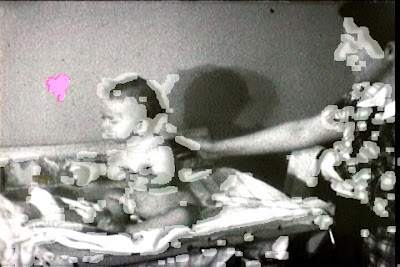=====================
I just finished a very exciting project: My mom located a really old family film from when she was a child back during the Great Depression! The film is absolutely one-of-a-kind and had become sort of a legend to me, as I'd heard that it existed but no one knew what had happened to it. Well, my mom found it several months ago and I secretly had it transferred to digital, in preparation for Mother's Day. This was not my first foray into the realm of digital film transfers and I wanted to do the best possible transfer of this priceless recording. And because it was on 16mm film I was hopeful that it would have significantly better picture quality than the less-old 8mm films I'd previously converted.
Now, there are lots of shops offering film-to-DVD transfer. But I've spent literally years searching for someone who could perform film-to-BluRay transfers, i.e., to capture the full picture quality, in high-definition. I finally located this shop:
Video Conversion ExpertsFor my little 11-minute film it cost $200 to transfer it to digital (at high-resolution) and create both a Bluray and DVD version. If I'd known all the work I was going to put into fixing the file I could've saved myself about half the cost and just requested the raw files; this is what ended-up happening anyways.
1010 W Chandler Heights Rd, Ste 2
Chandler, AZ 85248
www.videoconversionexperts.com
(800) 575-6202
(Actually, I just checked and they charge MORE for just giving you the raw files. Apparently they're charging you for the resulting picture quality rather than the amount of work required on their part.)
THE ORIGINAL TRANSFER
=====================
Alas, the film showed all the classic signs of old age. First of all, whoever owned the camera (which was surely a luxury back in the 1930's) didn't do a very good job with the settings. Most of the scenes were either over-exposed or under-exposed. And one segment of Christmas 1936 was out of focus for the entire time. Even worse, the film did not have the high-resolution of detail that I'd hoped for.
Most upsetting, however, was the amount of dirt on the film, especially in the first 30 seconds or so. I'd assumed that the film-transfer machines were capable of detecting and 'deleting' these problems. Instead, removing this dirt from the image was what inspired me to fix the entire film.
Actually, I wanted to fix the transfer and the DVD, as the version they sent me was accidentally recorded in "2-hr" mode (only 5 Mbps, or half the max) and with noticeable distortion. Since it was such a short piece of film there was no reason not to have recorded it at maximum quality, 10 Mbps or "1-hr" mode in their parlance. They also billed me unnecessarily for audio transfer (there was none). Rather than ask for a refund I asked them to just send me the original raw high-definition files. They described them as "HD-AVI" and so I was curious to see what they meant by that. Basically, their film-transfer machine outputs 1920x1080i HDV (M-JPEG). I did some quick tests and found that the compression was set at 85%, a reasonable setting but one that I ignored during my subsequent editing.
THE SOFTWARE I USED
=====================
- VirtualDub 1.8.8
www.virtualdub.org - AviSynth 2.5.6
www.avisynth.org - De-Spot filter for Avisynth
avisynth.org.ru/despot/despot.html - FFDshow
www.videohelp.com/tools/ffdshow
Note - All of these programs are open-source software, i.e., they cost nothing to use!
The one commercial program I used was Nero Vision (from the Nero Ultra Suite) to create a new DVD with menu and soundtrack.
THE GENERAL PROCEDURE
=====================
The first thing I did was identify what format everything was recorded-in. I then used VirtualDub to demux the original AVI (separate the audio and video streams). Even with 85% quality/compression the resulting video file was 6 GB (for 11 minutes!). Finally, I setup an initial AVS script, both to trim the black segments on left/right (the film had an aspect ratio of 4:3 whereas the 'high definition' transfer was done at 16:9 widescreen) and also to start experimenting with the Despot settings.
Here's what my AVS script looked like for the first segment:
(subsequent segments were similar with only slight adjustments to the Despot parameters)
------------I was then able to open the .AVS file directly in Virtualdub and immediately see the effect. Note the use of 'show=1' in the Despot parameters -- this produced a very cool diagnostic effect! Instead of showing the final result, the diagnostic mode shows you a colored-in version where you can see which parts of the image look like 'dirt' but are being left-alone because of Motion Estimation (shown in gray) versus which parts will actually be removed (shown in purple).
# REMOVE DIRT FROM 1ST SCENE (FRAME 1-64)
AVIsource("16mm_HDAVI.avi")
# SelectEven() to reduce frame-rate by half
SelectEven()
# Crop(Left-Pos,Top-Pos,Right-Size,Bottom-Size)
Crop(250,0,1440,0)
# run 'despot' plugin for old film
LoadPlugin("c:\program files\avisynth 2.5\plugins\despot.dll")
ConvertToYV12()
## Default settings for p1, p2, and mthres
#DeSpot(p1=24, p2=12, mthres=16, sign=1, minpts=10, interlaced=false)
# p1=sensitivity for detecting new dirt spots
# p2=sensitivity for finding the edges of dirt spots
# mthres=sensitivity for differentiating dirt spots from spots in-motion
# include 'show=1' for diagnostic mode
DeSpot(p1=64, p2=8, pwidth=540, pheight=300, minpts=80, mthres=43, show=1)
ConvertToRGB24
------------

One question I had was about removing the duplicate frames. The original file was 1080i 29.97 fps and every other frame was a duplicate (which interfered with detecting dirt on individual frames!). I used the 'SelectEven' command in my script and this removed the duplicates while also reducing the frame-rate to 14.985. Most importantly, it didn't seem to reduce the resolution. I had read that M-JPEG was recorded in interlaced format and so I was afraid that SelectEven might result in a 1920x540 image; it didn't.
Whew! This is by far my longest blog entry to-date. So I think I'll take a break, make this a two-parter. In my next blog entry I'll detail the method I used to tune the de-spot filter. It was as much an art as a science!

No comments:
Post a Comment